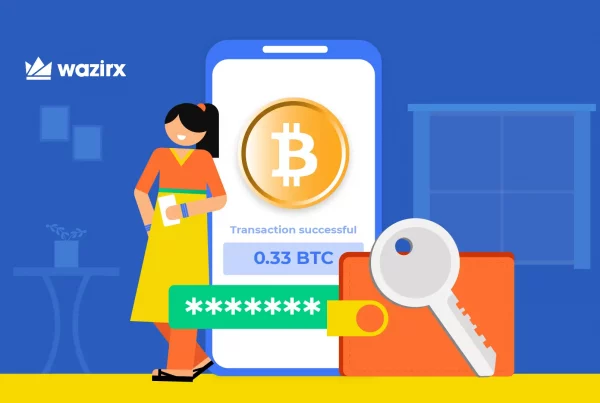Table of Contents
Note: This blog is written by an external blogger. The views and opinions expressed within this post belong solely to the author.
The study, which surveyed 154 nations, found that global crypto adoption rose by more than 881% over the last year and by more than 2,300% since the third quarter of 2019. Published by blockchain research platform Chainalysis, the 2021 Global Crypto Adoption Index placed India second in the world in terms of cryptocurrency adoption. In a nation where a banking ban on cryptocurrency was in place just 2 years back, adoption has been stupendous.
Such a development can only be symbolic of the commence of an era where the economy is going completely digital. It’s a very popular notion that innovation is inevitable, and cryptocurrencies along with their underlying blockchain technology have emerged as the next innovation in the modern-day economy.
There is virtually little influence on the continuing growth of the space, even if crypto is outlawed or restricted in some areas. Much has been written about the news coming out of mainland China, where different agencies and governing bodies have once again prohibited and/or barred some companies from trading in bitcoin and other cryptocurrencies. These reports came on the heels of multiple enforcement actions aimed against bitcoin miners for various environmental and power consumption issues.
As has previously occurred, the stated prohibitions and subsequent ripple effects have put substantial downward pressure on the price of bitcoin and other cryptocurrencies. Putting aside the concern that such volatility might cause for certain investors, these basically turn out to be short-term clutter. Bans have a long history of failing across geographic and economic boundaries; if the market wants a product or service, people will find a way to get it.
The global pandemic has only accelerated the growing trend of making payments online, meaning more and more people are beginning to realize the benefits of a token-based economy. Meanwhile, governments are increasingly recognizing the benefits that crypto can offer their economy.
Accelerating adoption (by addressing some issues)
Even though progress has been steady and the technology is extraordinary, the majority of the global population remains clueless and is excluded from the ecosystem. But why?
Complexity Of Cryptocurrency Concepts For Beginners
Entering the realm of cryptocurrency is frequently compared to falling into a rabbit hole since we have no clue where this may go. There are currently far too few people that fall into this category for a good cause. The learning curve in the realm of cryptocurrency and Blockchain is everything but simple and straight.
Many abstract and technical topics are difficult for some individuals to grasp, which discourages newcomers. It will be critical to make these complicated thoughts and ideas more accessible to the general public for them to be widely adopted.
Fortunately, the democratization movement is already well-organized, with a wealth of materials available in both digital and physical formats. However, efforts to teach and educate the general people are insufficient. It is also important to make sending bitcoins to another individual as simple as possible.
Furthermore, carrying out a cryptocurrency transaction should become simple. In general, when carrying out transactions, the ordinary user of a payment system does not want to hear about private keys or other cryptographic notions. On the contrary, such ideas will terrify people and act as a stumbling block. As a result, private key management systems play a vital role in making them easy for users.
In addition to the training effort to be conducted with individuals, it is critical to prioritize business education. The incorporation of Blockchain into existing corporate operations will be a critical step in introducing Blockchain to the broader public. As a result, the first critical aspect that must be addressed in order to gain broad acceptance of cryptocurrencies is training.
Volatility
Even if the general public is unfamiliar with cryptocurrencies, one of its features has been mentioned at least once. Volatility is a trait. Thus, the price of Bitcoin or other cryptocurrencies might rise by 20% one day and fall by 20% the next. These upward or downward swings might happen in a matter of hours. Not a week goes by without the media highlighting cryptocurrency volatility as one of the most serious threats to them.
In the eyes of traders, Volatility is a positive thing since it indicates the prospect of generating significant gains. However, the excessive speculation surrounding cryptocurrencies tends to obscure what is truly significant about them, notably the revolutionary nature of underlying technology like the Blockchain.
Unfortunately, the general media appears to be more interested in Bitcoin’s price than in these new innovations. All of this comes at the expense of the ordinary population, who struggles to understand what is truly essential about cryptocurrencies.
On the other hand, the volatility of Bitcoin creates a monetary risk that impacts the usage of Bitcoin as a means of exchange. While this volatility might enhance your purchasing power as a consumer, it can also drastically diminish it, and for many, this level of risk is unacceptable. As a result, the majority of these cryptocurrencies are viewed as digital speculative assets rather than as a means of exchange that can be utilized in regular activities.
Stablecoins, which attempt to mitigate the extreme volatility of cryptocurrencies such as Bitcoin, may play a role in the future as an essential means of digital exchange with the general population.
Scalability
For broad adoption of Bitcoin or other cryptocurrencies to occur, the existing infrastructure must be able to process the number of transactions that would be carried out as the number of users on the Blockchains increases. We’ve all seen examples of immature infrastructures being unable to scale up in order to handle a huge surge of consumers.
A big issue is also the substantial increase in transaction costs when the number of transactions to be validated increases – as we have witnessed with Ethereum and Bitcoin on multiple occasions.
This issue, in the case of Ethereum, created massive delays on the network. This is why the Ethereum 2.0 project was established to migrate the network to a more robust platform. Of course, the community is aware of these issues, and efforts to find solutions are being made.
In the future, the Lightning Network may enable Blockchain Bitcoin to go to the next level in terms of transactions validated per second.
It remains to be seen if the community’s attempts to enhance Bitcoin’s scalability will be effective and adequate to accommodate the rising number of transactions in the event of broad adoption by the general public.
Speculative approach
Many community participants opt for a short-term strategy – purchasing Cryptocurrencies only for speculative purposes. This significantly hinders the general public’s potential adoption of Cryptocurrency. India or any other developing nation is a great example. The majority of masses flocking to cryptocurrencies came on the heels of the impressive bull run from Bitcoin and other cryptocurrencies like DOGE. But, not many are interested in the technological aspects.
Indeed, by amassing Cryptocurrencies without intending to use them via transactions, the price of a crypto like Bitcoin grows, and it can only serve as a store of wealth.
It is hoped that this condition will improve with time. In fact, it already has. Believe it or not, even India is home to multiple businesses that accept cryptocurrencies like Bitcoin as a form of payment. The fact that more and more physical shops accept Bitcoin as a form of payment is a step in the right direction toward ensuring that cryptocurrencies stay a genuine medium of exchange.
Finally, it must be kept in mind that establishing a new business that defies current standards necessitates a significant amount of labor and, as a result, patience. When you look back over the last ten years, the effort made and the emergence of Bitcoin is quite remarkable. As a result, it is important to be patient and maintain the forward march while being hopeful about crypto’s ability to win over the broader public.
Conclusion
Fortunately, efforts are being made both in India and across the globe to promote proper crypto education. Meanwhile, regulators across multiple nations are drafting laws that better define the position of cryptocurrencies within the current economy while providing safeguards for investors.
Everyone who understands and loves crypto will have the capacity to accelerate its adoption as we continue educating the world around us and develop solutions to address the issues mentioned above.
Disclaimer: Cryptocurrency is not a legal tender and is currently unregulated. Kindly ensure that you undertake sufficient risk assessment when trading cryptocurrencies as they are often subject to high price volatility. The information provided in this section doesn't represent any investment advice or WazirX's official position. WazirX reserves the right in its sole discretion to amend or change this blog post at any time and for any reasons without prior notice.










